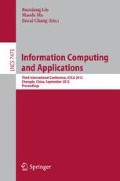Abstract
An improved reducing algorithm for rough set attributes has invented for answering the question of the excessive features vector dimensions. It obtains the local feature vector through geometric feature points. By introducing the rough set and improved reducing algorithm that it is able to select optimally among the existing expression features, also clipping the redundancy and useless information for the selection of expression feature. The experiment has showed that, this method has demonstrated high level of validity for its more convenience, higher recognition rate and more efficiency.
Access this chapter
Tax calculation will be finalised at checkout
Purchases are for personal use only
Preview
Unable to display preview. Download preview PDF.
References
Cootes, T.F., Edwards, G.J., Taylor, C.J.: Active appearance models. IEEE Transactions on Pattern Analysis and Machine Intelligence 23, 681–685 (2001)
Cho, M.G.: A new gesture recognition algorithm and segmentation method of Korean scripts for gesture-allowed ink editor. Information Sciences 176(9), 1290–1303 (2006)
Cootes, T.F., Taylor, C.J., Cooper, D.H., Graham, J.: Active shape models – their training and application. Computer Vision and Image Understanding 61, 38–59 (1995)
Pantic, M., Rpthkrantz, L.J.M.: Expert system for automatic analysis of facial expressions. Image and Vision Computing 18(11), 881–905 (2000)
Jolliffe, I.T.: Principal Component Analysis. Springer, New-York (1986)
Krzanowski, W.J.: A Stopping Rule for structure-Preserving Variable Selection. Statistics and Computing 6, 51–56 (1996)
Ginneken, B.V., Frangi, A.F., Staal, J.J., Romeny, B.M., Viergever, M.A.: Active shape model segmentation with optimal features. IEEE Transactions on Medical Imaging 21(8), 924–933 (2002)
Khanum, A., Mufti, M., Javed, Y., et al.: Fuzzy case-based reasoning for facial expression recognition. Fuzzy Sets and Systems 160(2), 231–250 (2009)
Yan, S.C., Liu, C., Li, S.Z., Zhang, H.J., Shum, H.Y., Cheng, Q.S.: Face alignment using texture-constrained active shape models. Image and Vision Computing 12, 69–75 (2003)
Kim, J., Cetin, M., Willsky, A.S.: Nonparametric shape priors for active contour-based image, segmentation. Signal Processing 87(12), 3021–3044 (2007)
Larsen, R., Stegmann, M.B., Darkner, S., Forchhammer, S., Cootes, T.F., Ersboll, B.K.: Texture enhanced appearance models. Computer Vision and Image Understanding 106, 20–30 (2007)
Li, S.Z., Xue, Z., Teoh, E.K.: Bayesian shape model for facial feature extraction and recognition. Pattern Recognition 36, 2819–2833 (2004)
Shih, F.Y., Chuang, C.F.: Automatic extraction of head and face boundaries and facial features. Information Sciences 158, 117–130 (2004)
Wan, K.W., Lam, K.M., Ng, K.C.: An accurate active shape model for facial feature extraction. Pattern Recognition Letters 26, 2409–2423 (2005)
Wong, W.T., Shih, F.Y., Liu, J.: Shape-based image retrieval using support vector machines, Fourier descriptors and self-organizing maps. Information Sciences 177(8), 1878–1891 (2007)
Afzal, S., Sezgin, T.M., Gao, Y., Robinson, P.: Perception of emotional expressions in different representations using facial feature points. In: Affective Computing and Intelligent Interaction and Workshops, Amsterdam, Holland, pp. 1–6 (2009)
Mower, E., Mataric, M.J., Narayanan, S.S.: A framework for automatic human emotion classification using emotional profiles. IEEE Trans. Audio Speech Language Process. 19(5), 1057–1070 (2011)
Lee, C.-C., Mower, E., Busso, C., Lee, S., Narayanan, S.: Emotion recognition using a hierarchical binary decision tree approach. In: Proc. Interspeech (2009)
Author information
Authors and Affiliations
Editor information
Editors and Affiliations
Rights and permissions
Copyright information
© 2012 Springer-Verlag Berlin Heidelberg
About this paper
Cite this paper
Li, D., Tian, Y., Wan, C., Liu, S. (2012). Facial Expression Feature Selection Based on Rough Set. In: Liu, B., Ma, M., Chang, J. (eds) Information Computing and Applications. ICICA 2012. Lecture Notes in Computer Science, vol 7473. Springer, Berlin, Heidelberg. https://doi.org/10.1007/978-3-642-34062-8_21
Download citation
DOI: https://doi.org/10.1007/978-3-642-34062-8_21
Publisher Name: Springer, Berlin, Heidelberg
Print ISBN: 978-3-642-34061-1
Online ISBN: 978-3-642-34062-8
eBook Packages: Computer ScienceComputer Science (R0)

